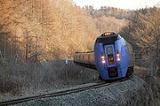
Super Ozora
Encyclopedia
The is a limited express
train service between and in Hokkaido
, Japan, operated by Hokkaido Railway Company
(JR Hokkaido). There are seven trains per day running in both directions, with the fastest journeys taking 3 hours 35 minutes.
and Asahikawa
using KiHa 80 series DMUs with one return working daily. The service was extended to run between Hakodate and Kushiro
from 1967. By 1973, there were three return workings daily. In October 1980, following the opening of New Chitose Airport
, services were reorganized, with just one return working daily between Sapporo and Kushiro. From October 1981, the train was rerouted via the Sekishō Line
, reducing journey times by approximately one hour. From 22 March 1997, four Ōzora services were upgraded to become Super Ōzora following the introduction of new KiHa 283 series tilting DMUs. The remaining Ōzora services using KiHa 183 series DMUs were phased out by 2001.

, at around 21:55 after car number 2 of the 6-car formation became derailed. The train caught fire, and all of the 245 people on board, including train staff eventually evacuated the train. 39 were treated for smoke inhalation and minor burn injuries. The burnt-out train was removed from the tunnel on 29 May 2011.
Limited express
A limited express is a type of express train service. It refers to an express service that stops at a limited number of stops in comparison to other express services on the same or similar routes.- Japan :...
train service between and in Hokkaido
Hokkaido
, formerly known as Ezo, Yezo, Yeso, or Yesso, is Japan's second largest island; it is also the largest and northernmost of Japan's 47 prefectural-level subdivisions. The Tsugaru Strait separates Hokkaido from Honshu, although the two islands are connected by the underwater railway Seikan Tunnel...
, Japan, operated by Hokkaido Railway Company
Hokkaido Railway Company
The is one of the constituent companies of Japan Railways Group , and thus often known as . It operates intercity rail services in Hokkaido, Japan. The company introduced Kitaca, a smart card ticketing system, from autumn 2008....
(JR Hokkaido). There are seven trains per day running in both directions, with the fastest journeys taking 3 hours 35 minutes.
History
The service commenced as the limited express on 1 October 1961, operating between HakodateHakodate Station
is a railway station in Hakodate, Hokkaido, Japan, operated by the Hokkaido Railway Company . It is the terminus of the Hakodate Main Line and the Tsugaru-Kaikyō Line; Hakodate Municipal Transit streetcars stop at the adjacent Hakodate Eki-mae Station....
and Asahikawa
Asahikawa Station
is a railway station located in Asahikawa, Hokkaidō, Japan. It is operated by the Hokkaido Railway Company .Asahikawa Station is the central train station of Asahikawa City, which is third by population in Northern Japan after Sendai City, and second after Sapporo City in Hokkaido.-Lines:The...
using KiHa 80 series DMUs with one return working daily. The service was extended to run between Hakodate and Kushiro
Kushiro Station (Hokkaido)
is the main railway station in the city of Kushiro in Hokkaidō. It is located on the Nemuro Main Line. The Senmō Main Line trains also terminate here.-External links:*...
from 1967. By 1973, there were three return workings daily. In October 1980, following the opening of New Chitose Airport
New Chitose Airport
, is an airport located south southeast of Chitose and Tomakomai, Hokkaidō, Japan, serving the Sapporo metropolitan area. By land area, it is the largest airport in Hokkaidō....
, services were reorganized, with just one return working daily between Sapporo and Kushiro. From October 1981, the train was rerouted via the Sekishō Line
Sekisho Line
The is a railway line in Japan operated by Hokkaido Railway Company . The main Sekishō Line runs between in Chitose and Shintoku Station in the town of Shintoku. A branch line runs from to...
, reducing journey times by approximately one hour. From 22 March 1997, four Ōzora services were upgraded to become Super Ōzora following the introduction of new KiHa 283 series tilting DMUs. The remaining Ōzora services using KiHa 183 series DMUs were phased out by 2001.
Rolling stock

- KiHa 80 series DMUs
- KiHa 183 series DMUs (1980–2001)
- KiHa 283 series Tilting DMUsTilting trainA tilting train is a train that has a mechanism enabling increased speed on regular rail tracks. As a train rounds a curve at speed, objects inside the train experience centrifugal force. This can cause packages to slide about or seated passengers to feel squashed by the outboard armrest due to...
(Super Ōzora from 1997)
2011 derailment and fire
On 27 May 2011, the Super Ōzora 14 service from Kushiro to Sapporo was brought to an emergency stop inside the 685 metre-long No. 1 Niniu Tunnel in Shimukappu, HokkaidōShimukappu, Hokkaido
-External links:* *** in English and Japanese...
, at around 21:55 after car number 2 of the 6-car formation became derailed. The train caught fire, and all of the 245 people on board, including train staff eventually evacuated the train. 39 were treated for smoke inhalation and minor burn injuries. The burnt-out train was removed from the tunnel on 29 May 2011.

